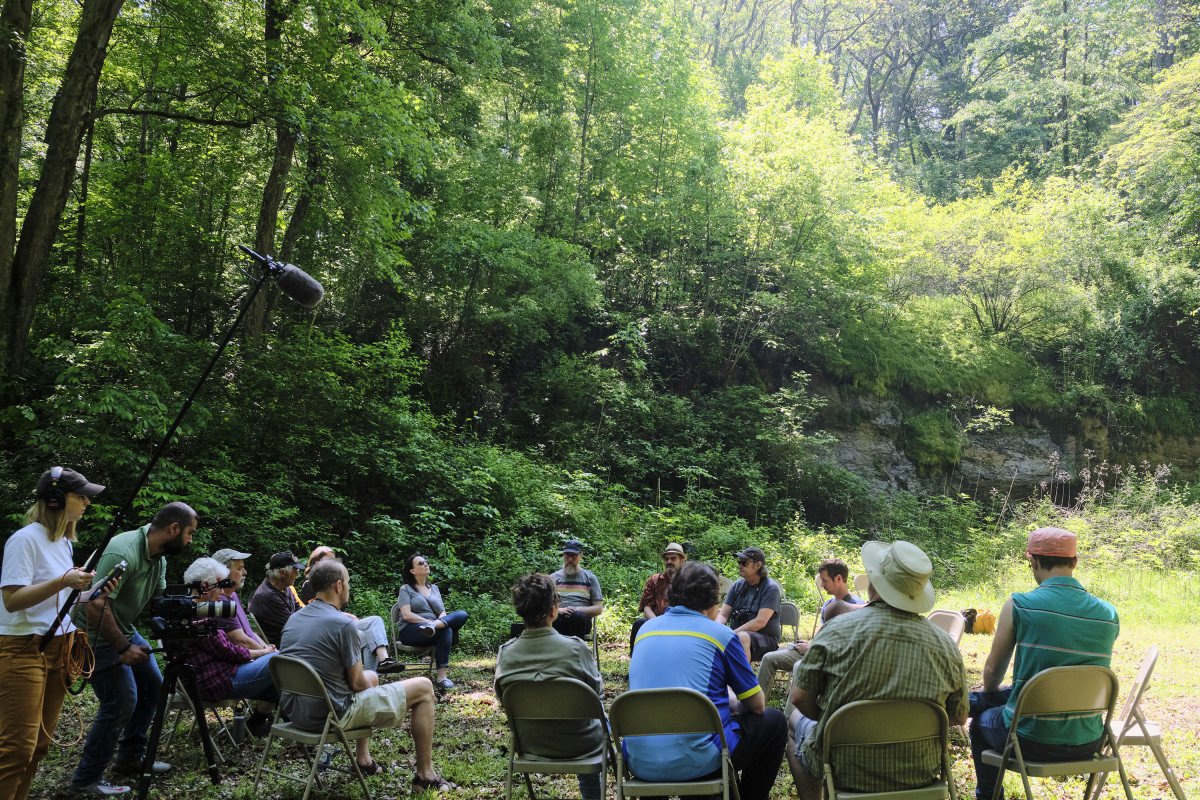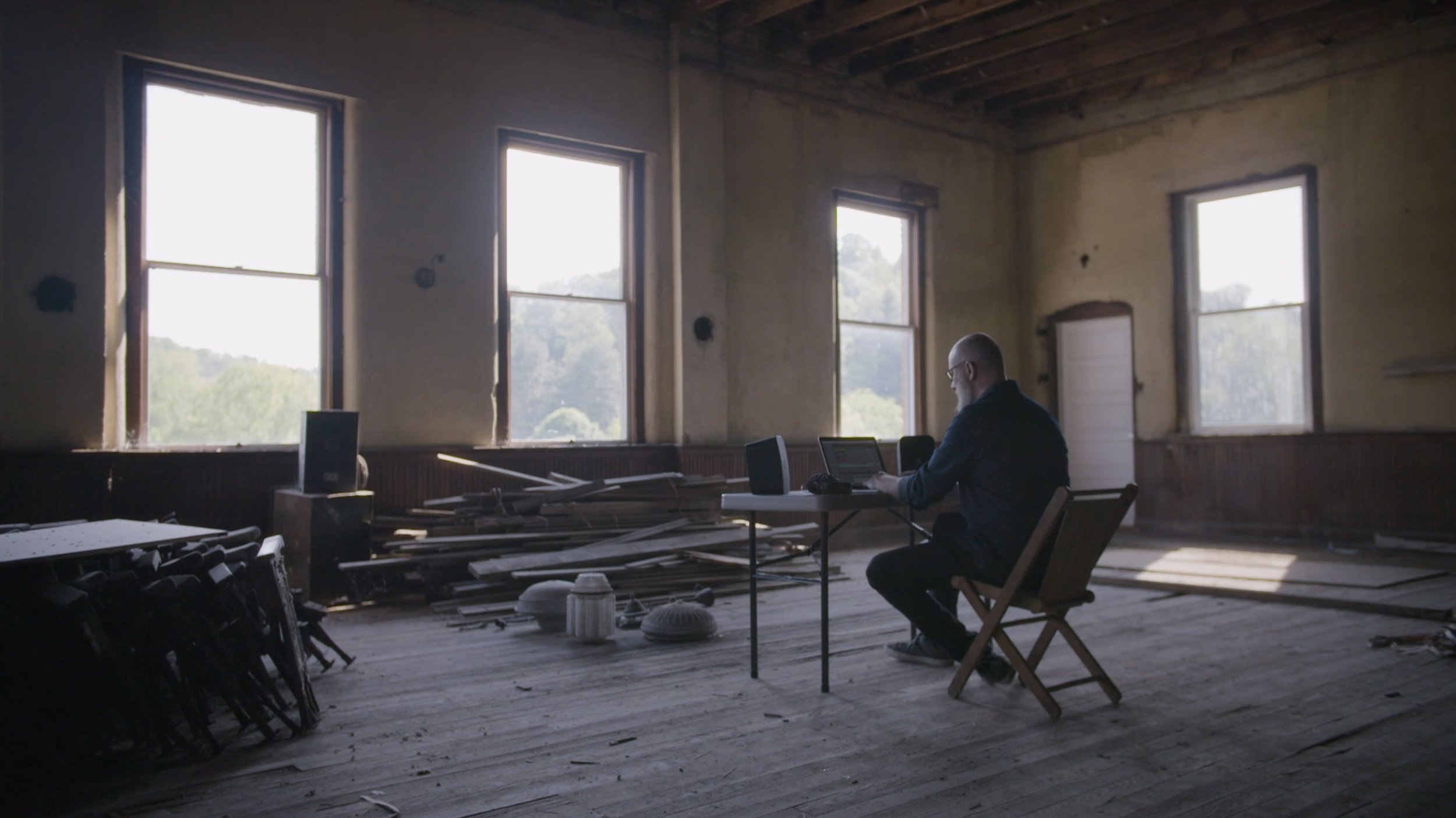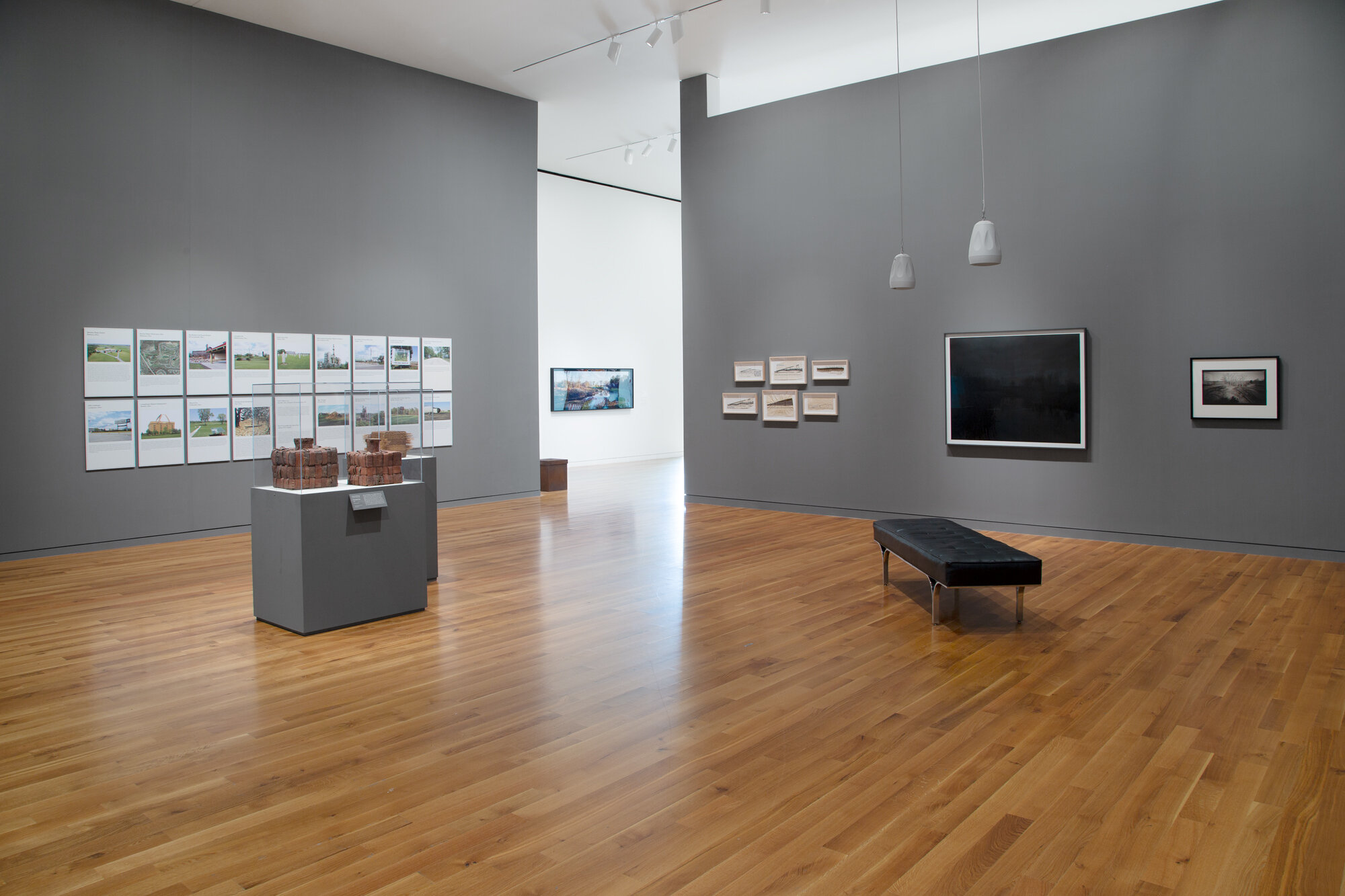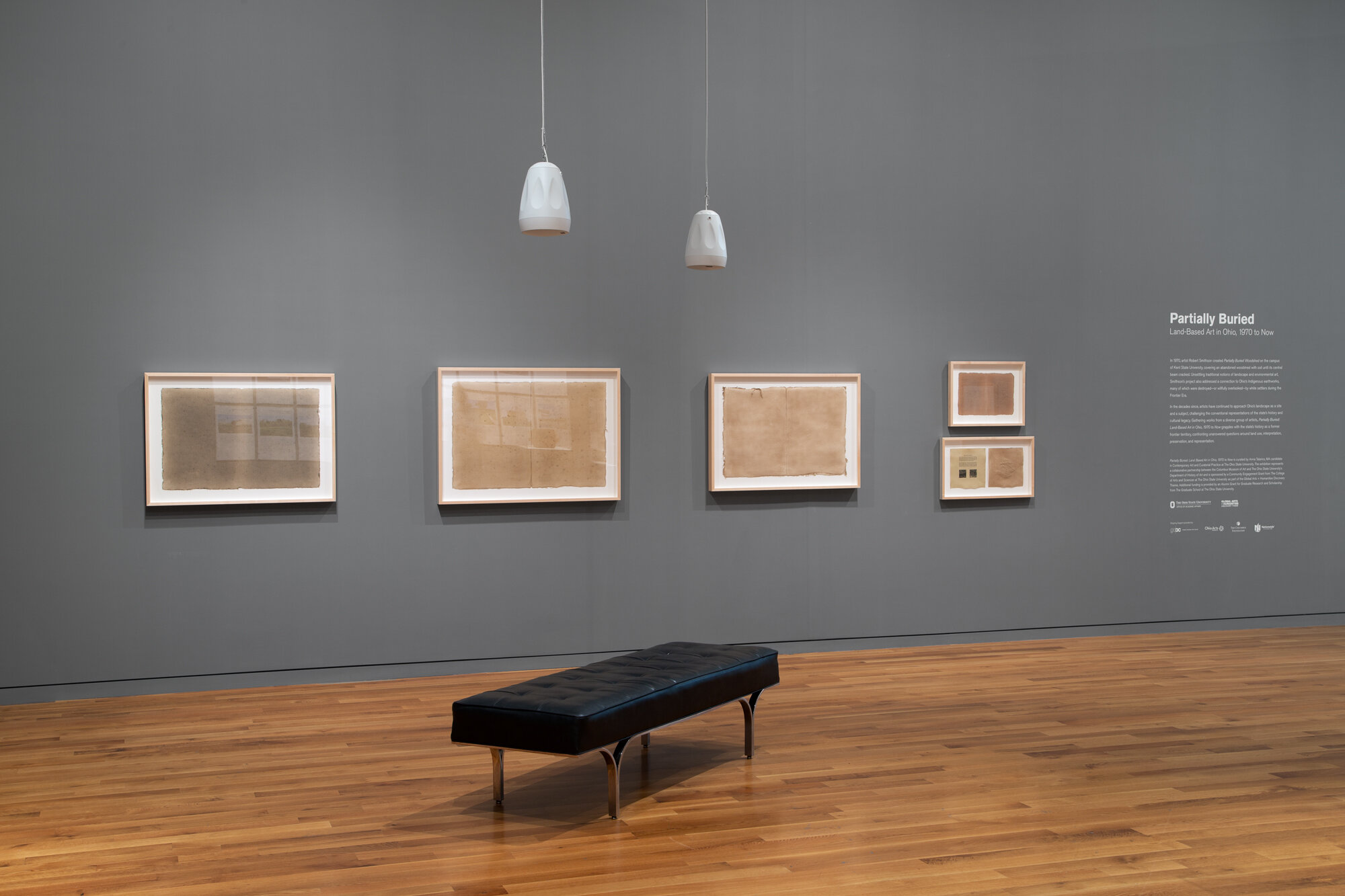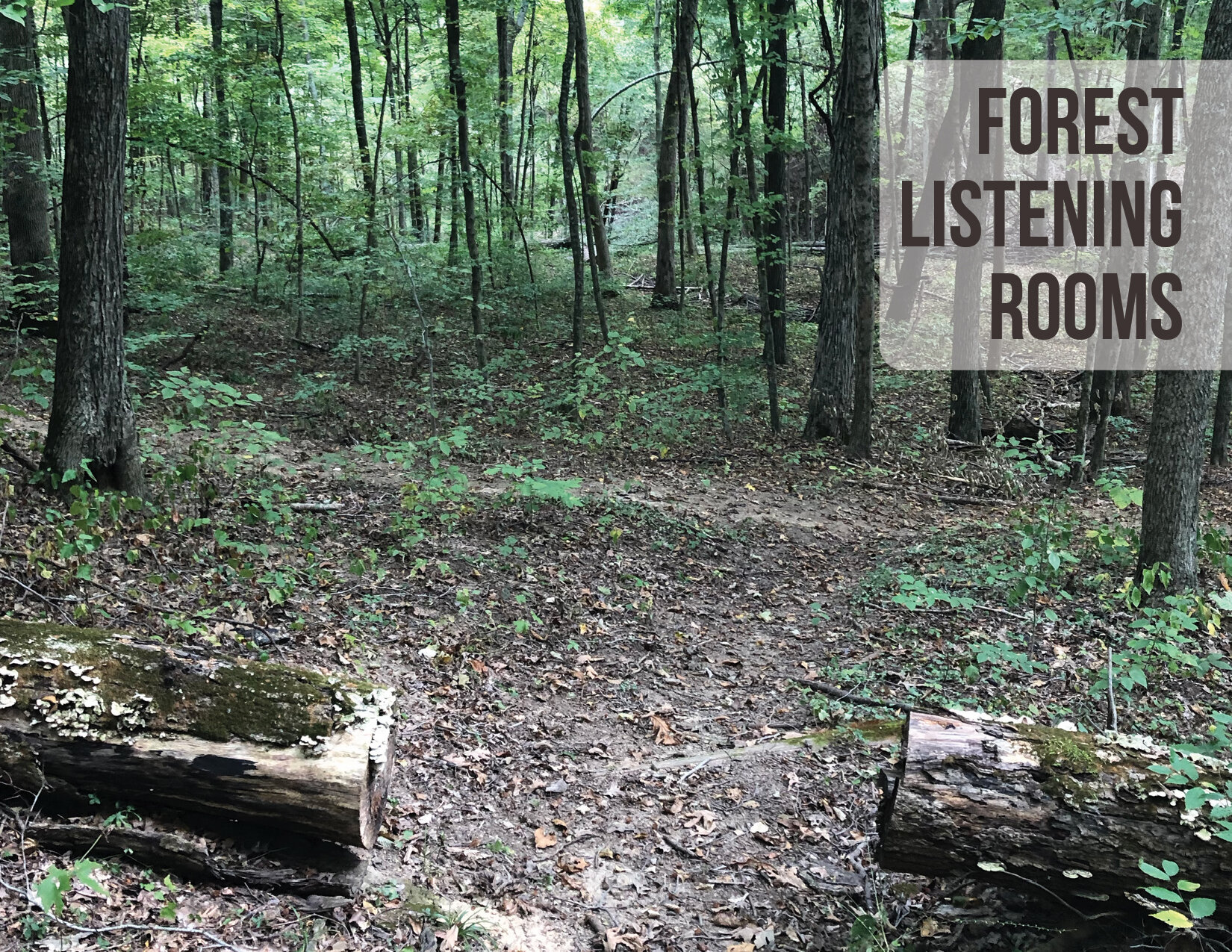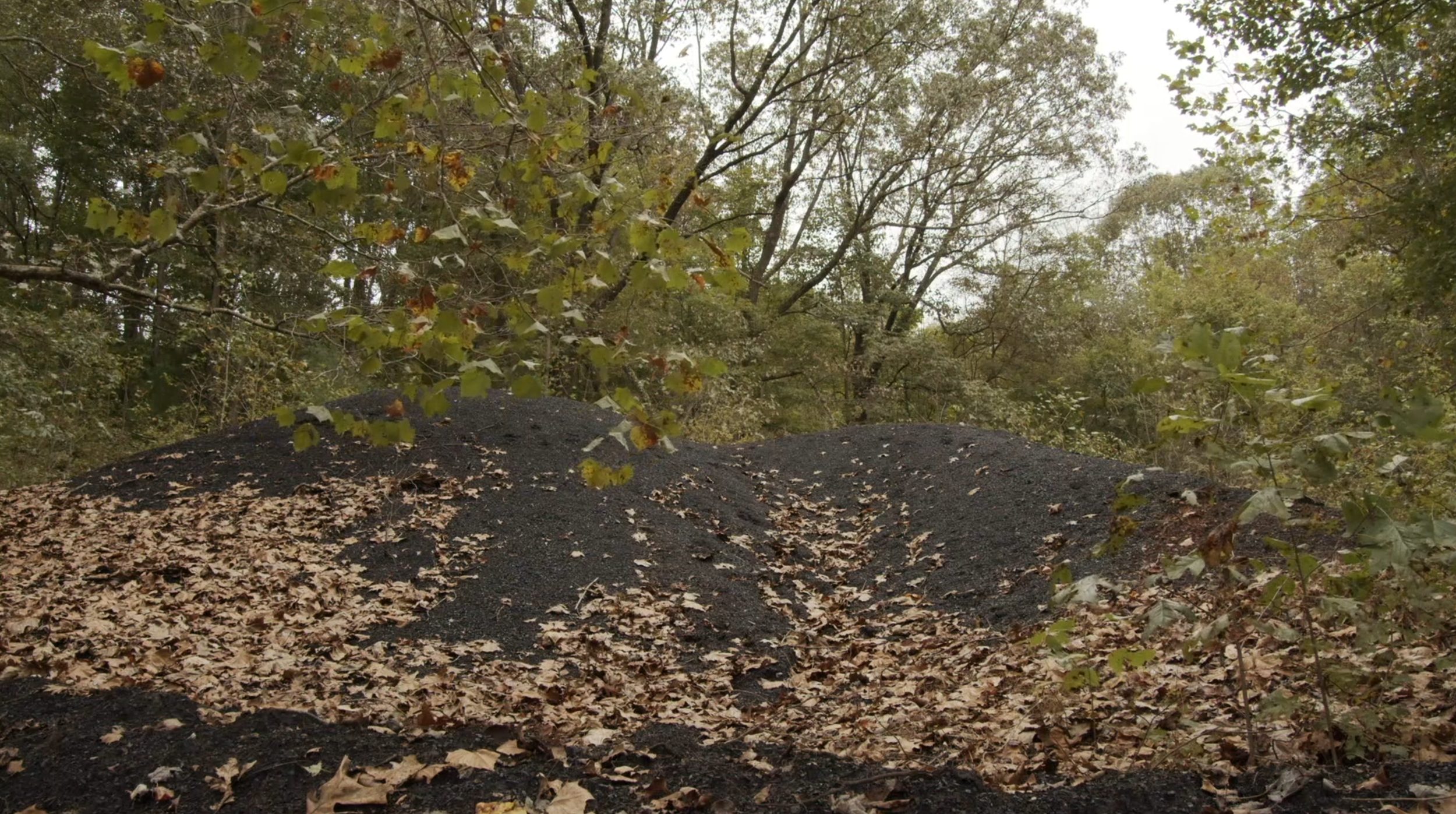FOREST LISTENING ROOMS (2018-present)
Forest Listening Rooms is a social practice sound, performance, and video project in the Wayne National Forest in Appalachian Ohio (USA). After the brutal removal of the Shawnee tribe in the early nineteenth century, the region has undergone two centuries of fossil fuel extraction, environmental degradation, and economic booms and busts. The project invites local communities to gather in outdoor spaces and critically listen to the forest, archival recordings of past residents, sounds of extraction, and to each other. Forest Listening Rooms contends that listening to the forest’s past and present can transform its future. Its goals are to understand differences between rural and urban communities, foster a sense of stewardship toward land use, and end hydraulic fracturing (“fracking”) on the forest’s contested public lands.
Forest Listening Rooms consists of dozens of iterations, ongoing since 2018. There is no single “performance” of the piece; instead, it is comprised of many experiences of listening followed by shared conversation, and is focused on land use, environmental issues, and the rural/urban divide. No two listening sessions are the same, as evinced by the documented examples below, which include children, hunters, all terrain-vehicle riders, environmental activists, concerned residents, oil drillers, community organizers, and local historians. Finally, the main audiences of Forest Listening Rooms are the local residents that live in Appalachian Ohio, and it is their experiences of listening that are the central components of the project.
The project’s process is as follows: community members begin with a sound walk (a quiet, mindful hike that pays attention to listening) in the forest to outdoor spaces (or, “rooms”), to listen in situ. Locations range from the cave where the United Mine Workers secretly formed, to a 130-year old mine fire, to a contemporary fracking drill site. In these spaces, participants experience soundscapes around them mixed with local archival recordings of past residents and miners (projected from audio speakers). Participants hear flowing water, bird calls, plantlife, industrial rhythms, and archival sounds of oral histories, disasters, and protest. Participants then listen to each other as they share their own experiences, hopes, and fears. These stories are recorded and remixed into future sessions, creating a continually expanding feedback loop. The result is a sonic map of the complex past and present of the forest, revealing thoughts, tensions, and emotions of its people.
Forest Listening Rooms was made possible through a Socially Engaged Art in Contemplative Practices Fellowship from A Blade of Grass.
LISTENING SESSION VIDEOS
OVERVIEW/ROBINSON’S CAVE - May, 2019
This listening session took place at Robinson’s Cave, the site where the United Mine Workers was formed in the nineteenth century. It is also the spot where miners conspired to set the mines on fire, which continue to burn today. Here, a group consisting of both local and urban residents listen together and share stories of the place, its labor history, and their hopes for its future.
PERRY STATE FOREST - April, 2019
This is a one-on-one listening session between Harnetty and Joelene Dixon, a local resident in Perry State Forest. Together, they listen to sites of past and future strip-mining. Dixon shares her concerns of the poorly managed ‘recovery’ of the forest, and the mining companies’ intentions to destroy the land again. They hear the silences of animal life, the sounds of acid mine drainage, and Dixon’s own connection to the land: a desire to stay in that place despite its degradation.
XX COAL MINE - October, 2018
In this listening session, participants take a soundwalk with Harnetty along a nineteenth century coal mine, where they hear and observe both sites of recovery and the scars of past extraction, including “gob piles” of coal, acid mine drainage, as well as mitigation efforts and newly built trails for local residents. They listen together in silence, followed by archival recordings of people who worked in this very place. Finally, participants shared their own stories about the forest and their own experiences of living, working, and walking in it.
WILDCAT HOLLOW - March, 2019
Local children meet Harnetty at Wildcat Hollow in the Wayne National Forest, Ohio, adjacent to the active Buckingham Coal Mines. They take a soundwalk together, and gather at a group of fallen mossy trees. They listen in silence together (no small feat), and immediately talk of what they heard: branches and birds, wind and voices, airplanes and industry. They then listen to music and archival recordings of children of past generations talking of mining. They finally tell their own stories, of their discoveries in the forest.
PARTICIPANT QUOTES
“It’s definitely a meditative space for me personally, but it’s also this really dense, complex, layered historical place that I don’t fully grasp or understand. You see the layers of undergrowth, layers of dirt and soil, trash, coal... layers that listening in a space can bring out.”
“When you look at public land, it’s no secret that people are pretty divided today. But this is something that both sides of the political spectrum agree on. I feel like it’s such a thing that can unite so many different factions that otherwise may not agree on many things.”
“I think the forest is what brought everybody together. Whether you don’t see eye to eye on the way the land is used, or whatever it may be, everybody has a connection with the land. And everybody has their own story here. So, no matter the differences, everybody is connected in a similar way, and it’s the forest.”
“The forest is winning the battle again; it’s coming back and taking over. I’ve decided it’s a good thing, to reclaim this land.”
“My parents are gone. And after my dad died...I wasn’t quite ready for the feeling of being an orphan. And something about being in an area that is familiar to you, that reminds you of your childhood, reminds you of carefree days, is comforting. I don’t know how else to say it, it’s just comforting. It’s home.”
“I go to the woods to recharge. I go to the forest. I think it is fascinating to look down and see the minutiae and feel big, and then look up and see the vastness and feel small without ever moving. I think it’s just a really great place to be. It connects me with my past and brings me to the present.”
“It seemed to me that [Harnetty] was being very careful not to influence you too much. He wanted what came out of the conversations to be mostly let in by the silences or the sounds of the woods or the other people. A lot of what he did was to just let us feel and talk about what we did feel and whatever memories those brought out.”
CRITICAL QUOTES
“Harnetty’s light touch allows Forest Listening Rooms to speak what Robin Wall Kimmerer (botanist and member of the Citizen Potawatomi nation) might call the ‘grammar of animacy.’ Kimmerer writes that when our language honors the animacy of all life forms—including those that English-speakers are used to describing as inanimate—we are able to come into relationships of reciprocity rather than exploitation. In FLR, we see one vision of this—as Harnetty puts it, participants envision a world in which ‘we could actually help change the place, to heal it, even at the same time as it was changing us.’”
“Maybe, Harnetty argues, if we listen to the forest together, we can alter its future.”
“Through the Sound Walk process, Harnetty is uplifting local people and honoring what they find meaningful. He hopes the Walks will play a role in community organizing efforts to stand up to fracking, the latest extraction effort coming into the region.”
“What do our National Forests sound like? And how do they make us feel? ... [Harnetty] uses the Wayne National Forest as a venue for a dialogue around American rural life and the land we live on.”
“Studs Terkel meets Brian Eno in the woods.”
“Harnetty’s work shows how composing sociality thrives through returning again and again to a community over a long period of time, with the commitment of an artist who maintains a presence, building trust over years, unlike the typical time frame of socially engaged artworks where an artist or collective moves in and then quickly out again.”
“A Blade of Grass Fellow Brian Harnetty is an artist who chose to stay... His commitment to place is a radical choice, in the original sense of ‘radical,’ meaning to have roots, specifically to share the experiences and concerns of communities to which we are accountable.”
LISTENING SESSION IMAGES
LISTEN: PODCASTS
Here is an episode of the Sound School Podcast with Rob Rosenthal, from Transom and PRX: “Studs Terkel Meets Brian Eno in the Woods.”
Listen to a podcast about Forest Listening Rooms produced in conjunction with the Phantom Power podcast (you can read the transcript here, courtesy of Phantom Power):
And, you can listen to this episode of Brian Koscho’s “Invisible Ground” here, about the Little Cities of Black diamonds. My interview is at the end:
Finally, you can listen to an episode of the podcast from the Center for Folklore Studies at The Ohio State University called “Covid Conversations,” where Forest Listening Rooms is discussed, here.
PERFORMANCES / LISTENING SESSIONS
XX Coal Mine, Shawnee, Ohio, with rural and urban participants
Tecumseh Lake Trail, Shawnee, Ohio, with residents of Shawnee
XX Coal Mine, Shawnee, Ohio, with residents of Shawnee
Lake Essington, Perry State Forest, Ohio, with local resident and environmental activist
Perry State Forest, Ohio, with ATV riders
Wayne National Forest, Corning, Ohio, with local hunter
New Lexington, with Friends of the Perry State Forest (local farmers, ATV riders, activists)
Wildcat Hollow, Wayne National Forest, Ohio, with local children
Junction City, Ohio, with local resident
Robinson’s Cave, New Straitsville, Ohio, with local and urban participants
Shawnee, Ohio, with local oil driller and resident
Frack waste injection wells, Athens County, Ohio, with local scholar and environmentalist
Buckeye Trail, Shawnee, Ohio, with both local and urban residents
Tecumseh Lake Trail, Shawnee, Ohio, with the Athens Photo Project (two listening sessions)
Strouds Run State Part, Athens, Ohio, with the Ohio Field School (Ohio State University)
ARTICLES / EXHIBITIONS
New Music Box: “Place, Sound, History, Now: Listening to the Little Cities of Black Diamonds” (an overview of the region)
Pacific Standard and Columbus Alive co-published feature article: “The Lost Art of Listening”
Resonance: The Journal of Sound and Culture: “Listening to the Democratic Forest with Brian Harnetty”
A Blade of Grass Magazine: “Stay, Listen, Organize: Bridging Appalachia’s Past and Present Through Sound”
The Daily Yonder and 100 Days in Appalachia: “The Sounds of Rural America”
The Bloomsbury Handbook of Sound Art: “Composing Sociality: Toward an Aesthetics of Transition Design”
A Blade of Grass: “Forest Listening Rooms: Field Research Report”
Guggenheim Environmental Justice Practicum: “The Forest as Mediator” in A Community is a Garden [PDF] and Sustainable Futures
National Forest Foundation: “If a Musician Plays in a Forest: How the Sounds of Our National Forests Make Music”
Columbus Museum of Art: “Partially Buried: Land-Based Art in Ohio, 1970 to Now”
Public Data Lab / Critical Zones Exhibition (ZKM Germany): ”Ways of Listening to Forests”
Otterbein University Miller Gallery (solo exhibition): “Common Ground: Sounds of Appalachian Ohio”
The Hoosac Institute: “An Interview With Brian Harnetty and Mary Lucier”
POSITIVE REGIONAL CHANGE
WOSU Radio (01/31/20): “Ohio EPA Terminates Permit for Proposed Mine in Perry State Forest.”
Ohio Environmental Council (03/17/20): “Court Stalls Fracking Leases in Ohio’s Only National Forest.”
Columbus Dispatch (10/11/20): “How Does a Former Coal-Mining Town Reinvent Itself?”
WHY FOREST LISTENING ROOMS?
A map of a Forest Listening Rooms sound walk in the Wayne National Forest.
After 80 years of recovery, Ohio’s Wayne National Forest (WNF) is once again under threat. New hydraulic fracturing (or, “fracking”) leases are greatly expanding gas and oil extraction there. This project asks: What does social change sound like? What are the stories of the forest and the people who live there? Through listening, how might people change personally, and how might they change the forest? Building on composer Pauline Oliveros’ meditative and communal “deep listening,” and the directive “What did you hear?” from the sound art collective Ultra Red, participants engage in listening to natural soundscapes around them, archival recordings, and each other’s stories. Past and present become conflated, bleeding into one another to create a space where listeners can address and enact a new future.
The region is deeply divided politically and socially. Residents find themselves caught between fighting for jobs in an economically depressed region, and fighting to end decades of environmental degradation. These differences often correspond to the political spectrum, pitting right against left. Despite divisions, local residents come together over senses of shared places and pasts: histories of the towns and forest; stories of immigration and racial tolerance; and celebrating the region’s long labor history. Through listening, this project asserts the key to social change here necessarily involves connections and discussions over this shared past, the land, and the forest: public lands that can be reclaimed through many different voices of dissent.
A postcard for one of the Forest Listening Rooms sessions.
Each part of this process is meant to build both a trust between participants –– who may come from different backgrounds, beliefs, or political convictions –– and encourage personal transformation through experiencing the sounds and silences of the forest. In each listening session, the forest became a mediator, a common point between participants, an opening to some small personal and social change.
At the heart of this project is a form of contemplative listening. Listening is an act of uncertainty. When we listen closely, we must be open, unsure of what sounds or words we might encounter. Straining to hear, we quiet inner voices and give up control, yet this unlocks new perspectives and visions; listening is thus an invitation to discover, change, transcend. These moments of openness and clarity are nowhere needed more than in our current political and ecological crises, where careful acts of listening have often ceased.
Parallel to the project, I joined AmeriCorps (2018-19) as a way of serving directly in Shawnee and in the Wayne National Forest. I joined with a local organization called Rural Action, under their Ohio Stream Restore Corps. As a volunteer, I worked with two organizations, Ohio’s Hill Country Heritage Area and The Winding Road; both are dedicated to improving the local economies of Appalachian Ohio. Now, I am continuing this work with non-profits to help tell the stories of the region, and to help build local economies and sustainable ecologies by and for the people there.
The poster for listening events in October, 2018.
A still from the film shows a “gob pile” from the XX Mine, unusable coal placed here over a century ago (Image: William Randall).
Many thanks to A Blade of Grass, Jess Holler, Kevin Davison, Joel Oliphint, William Randall, RAVA Films, Julia Main, Creative Capital, and John Winnenberg for their support on this project.


